[ad_1]
Damselfish are some of the most popular saltwater fish, because they are inexpensive, easy to care for, and hardy. But they can also be aggressive towards other fish in a community tank.
Here are 21 Popular Damselfish Types listed alphabetically by common name:
| 1. Ambon Damselfish | 8. Four Stripe Damselfish | 15. Rolland’s Damselfish |
| 2. Azure Damselfish | 9. Jewel Damselfish | 16. Talbot’s Damselfish |
| 3. Blue Devil Damselfish | 10. Lemon Damselfish | 17. Ternate Damselfish |
| 4. Blue and Gold Damselfish | 11. Neon Damselfish | 18. Three Spot Domino Damselfish |
| 5. Bluefin Damselfish | 12. Regal Damselfish | 19. Three Stripe Damselfish |
| 6. Blue Sapphire Damselfish | 13. Pink Smith Damselfish | 20. Two Stripe Damselfish |
| 7. Blue Velvet Damselfish | 14. Princess Damselfish | 21. Yellowtail Damselfish |
Ideal water parameters for Damselfish in a saltwater tank
Most Damselfish types are hardy, easy to care for saltwater fish that do not have very demanding, specific care requirements. The traditional reef aquarium water parameters will be a great fit for them:
- Temperature: 73 to 84 Fahrenheit
- pH: 8.1 to 8.4
- Salinity: 35 ppt (1.025 specific gravity
- Ammonia: 0 ppm
- Nitrite: 0 ppm
1. Azure Damselfish

The Azure Damselfish is one of the most beloved of the Damselfish Types, because of their bold and beautiful coloration and personalities.
| Scientific name | Chrysiptera hemicyanea |
| Minimum tank size | 20-gallons (75.7 L) |
| Adult fish size | 2.75 in. (7 cm) |
| Aggressiveness | Semi-aggressive |
| Reef safe | Yes |
| Care level | Easy |
2. Blue Devil Damselfish

The Blue Devil Damselfish is one of the most popular species. As their name suggests, they can be a bit of a devil in your community tank, claiming a large footprint of space in your tank as its own, and “defending it” vigorously.
They are omnivores that will occasionally pick at some algae in the tank, but they should also be fed a varied diet that includes meaty foods and algae-based preparations.
In some varieties, the male’s tail is actually orange.
| Scientific name | Chrysiptera cyanea |
| Minimum tank size | 20-gallons (75.7 L) |
| Adult fish size | 2.75 in. (7 cm) |
| Aggressiveness | Semi-aggressive |
| Reef safe | Yes |
| Care level | Easy |
3. Yellowtail Damselfish

The Yellowtail Damselfish is blessed with the reputation of being one of the least aggressive damselfish, which, along with their gorgeous coloration, hardy constitution and inexpensive price tag, makes them one of the most popular saltwater fish species.
Are yellow tail damselfish reef safe?
Yellow tail Damselfish are reef safe. They will peacefully interact with the corals, clams, and mobile invertebrates in your tank. They are also one of the more peaceful species of damselfish, which makes them less likely to squabble with the other fish in your reef tank, although some individuals will still be territorial.
| Scientific name | Chrysiptera parasema |
| Minimum tank size | 20-gallons (75.7 L) |
| Adult fish size | 2.75 in. (7 cm) |
| Aggressiveness | Semi-aggressive |
| Reef safe | Yes |
| Care level | Easy |
4. Blue Sapphire (Springer’s) Damselfish

Are Springer damsels aggressive?
Spring damsels are listed as “peaceful” on Saltwaterfish.com and Liveaquaria.com, but as is the case with most damselfish species, they will likely be aggressive towards peaceful, timid fish and other damselfish, including clownfish. My recommendation is to consider them semi-aggressive and avoid mixing with peaceful species.
| Scientific name | Chrysiptera springeri |
| Minimum tank size | 20-gallons (75.7 L) |
| Adult fish size | 2 in (5.1 cm) |
| Aggressiveness | Semi-aggressive |
| Reef safe | Yes |
| Care level | Easy |
5. Talbot’s Damselfish
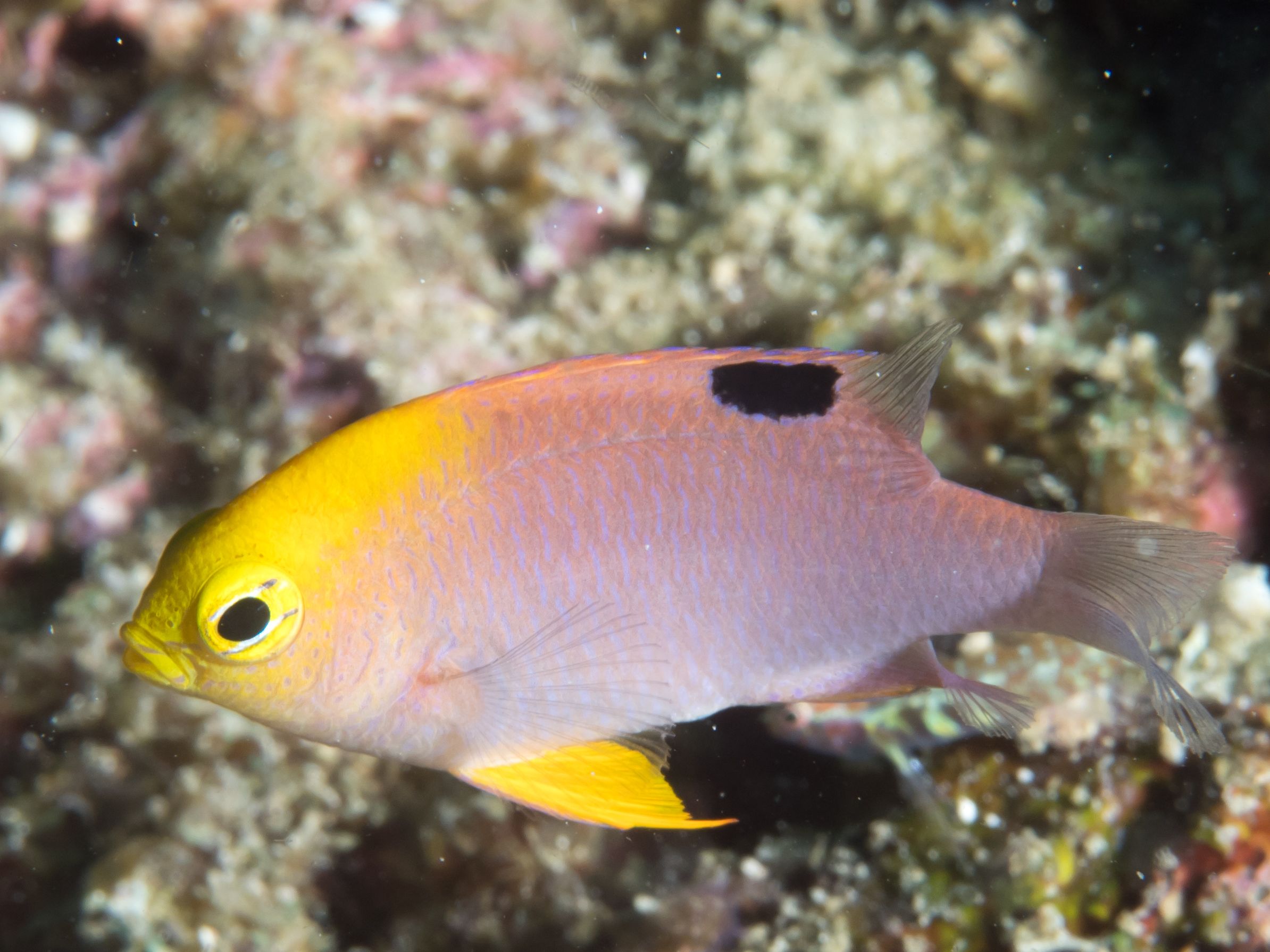
Talbot’s Damselfish is relatively mild-mannered, by damselfish standards, although there are frequent reports of certain individuals being quite territorial, despite their reputation. They come from the Indo-Pacific reefs and need a varied diet to remain healthy, like most Damsels.
| Scientific name | Chrysiptera talboti |
| Minimum tank size | 20-gallons (75.7 L) |
| Adult fish size | 2.25 in. (5.7 cm) |
| Aggressiveness | Semi-aggressive |
| Reef safe | Yes |
| Care level | Easy |
6. Rolland’s Damselfish
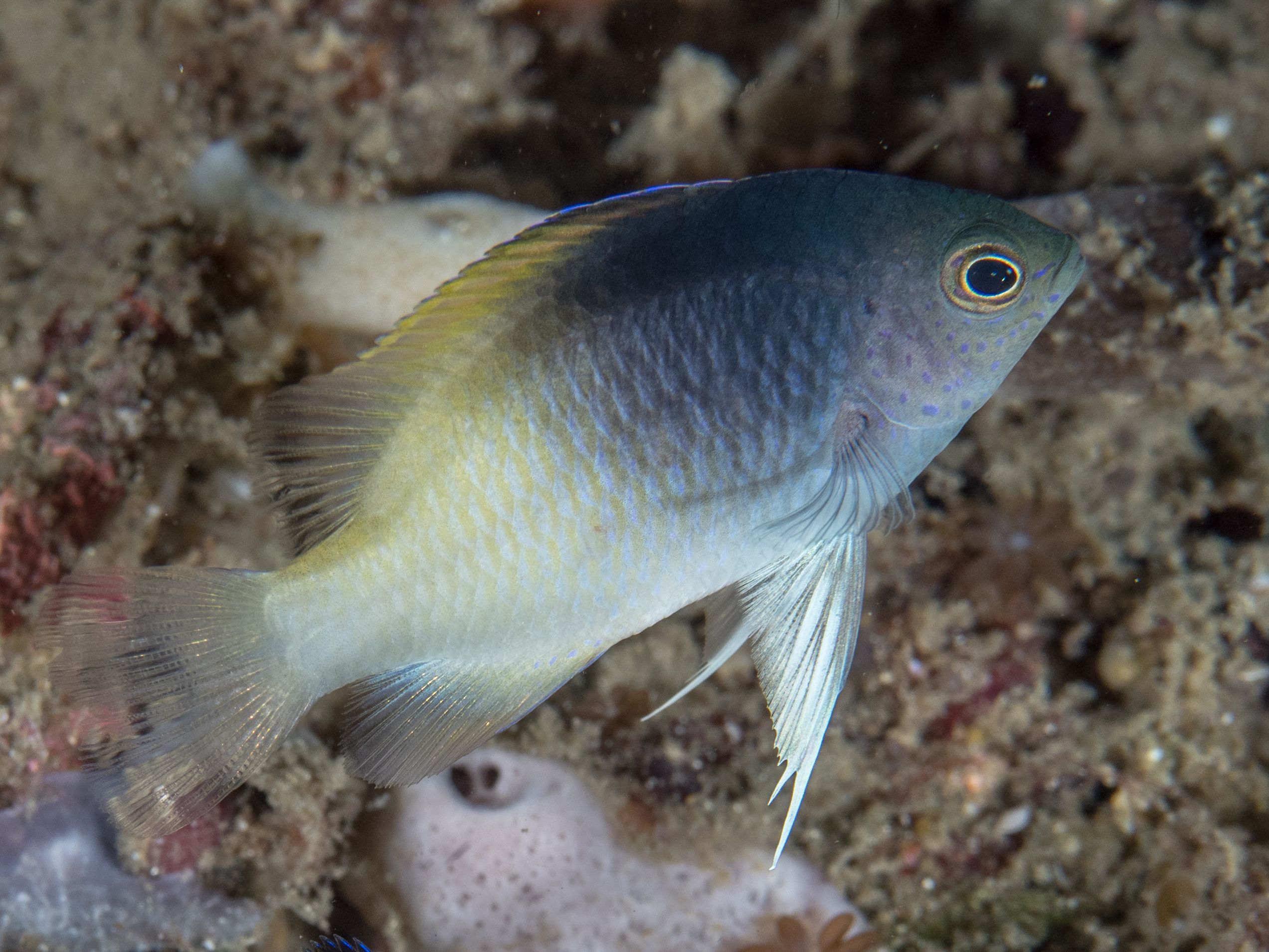
Rolland’s Damselfish is an attractive damselfish type with more subdued coloration and markings compared with the other show-offs in the Chrysiptera genus.
| Scientific name | Chrysiptera rollandi |
| Minimum tank size | 20-gallons (75.7 L) |
| Adult fish size | 3 in. (7.6 cm) |
| Aggressiveness | Semi-aggressive |
| Reef safe | Yes |
| Care level | Easy |
7. Princess Damselfish
The Princess Damselfish is perhaps the most strikingly beautiful of all the damselfish types on this list. Their coloration reminds me of the much coveted Flameback Angelfish. If I was going to risk aggression in my tank to add a Damselfish, it would be to add this beauty to my tank.
| Scientific name | Pomacentrus vainly |
| Minimum tank size | 20-gallons (75.7 L) |
| Adult fish size | 2.8 in. (7 cm) |
| Aggressiveness | Semi-aggressive |
| Reef safe | Yes |
| Care level | Easy |
8. Blue and Gold Damselfish (Goldbelly)
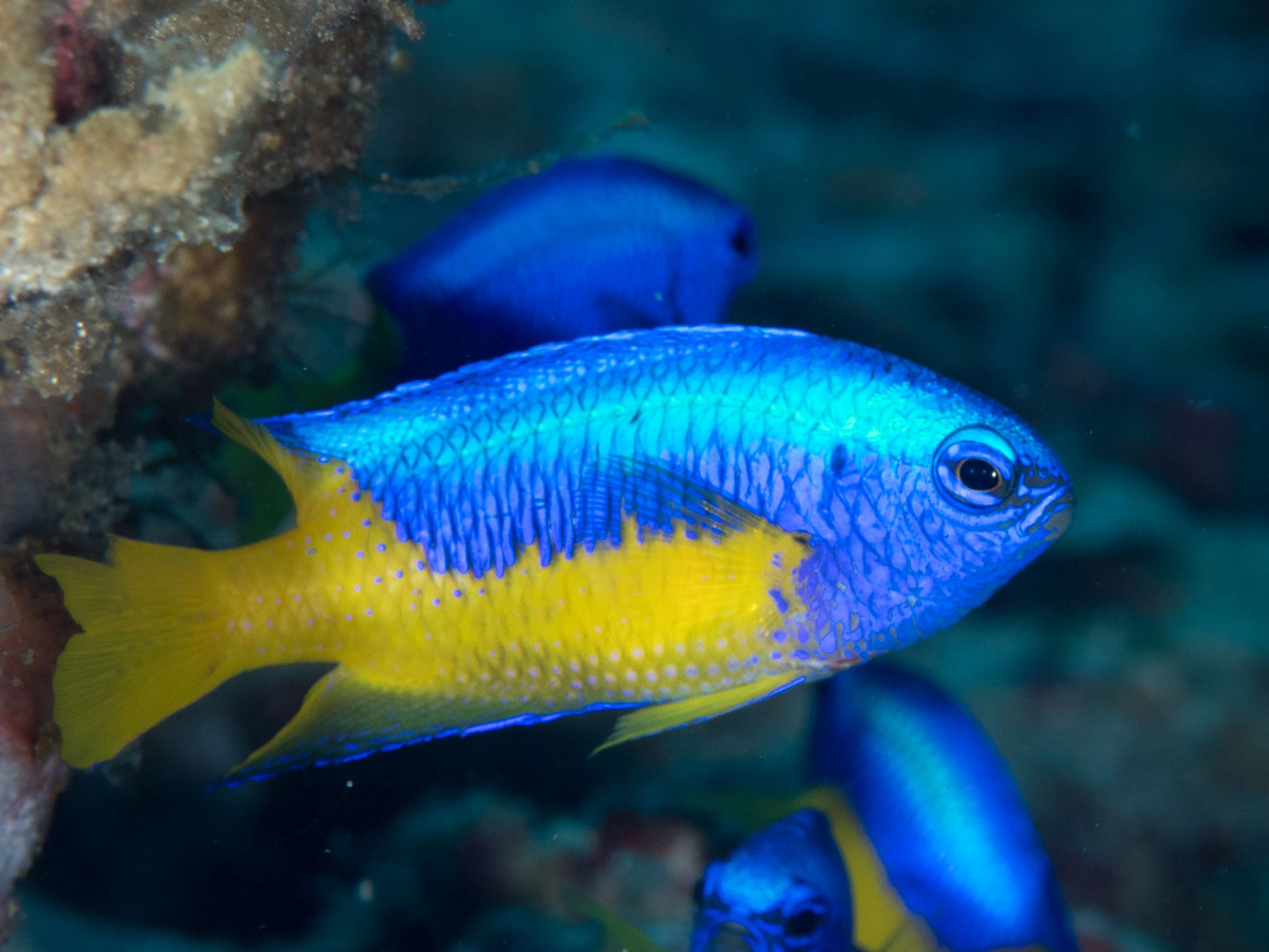
It is remarkable to me to see that there is a Damselfish type with just about any configuration of blue and gold that you can imagine. The Gold belly, or Blue and Gold Damselfish has a gold belly, as the name implies, that starts with the pectoral fin and extends all the way to the tail.
| Scientific name | Pomacentrus coelestis |
| Minimum tank size | 20-gallons (75.7 L) |
| Adult fish size | 3.5 in. (8.9 cm) |
| Aggressiveness | Semi-aggressive |
| Reef safe | Yes |
| Care level | Easy |
9. Neon Damselfish (Allen’s Damselfish)
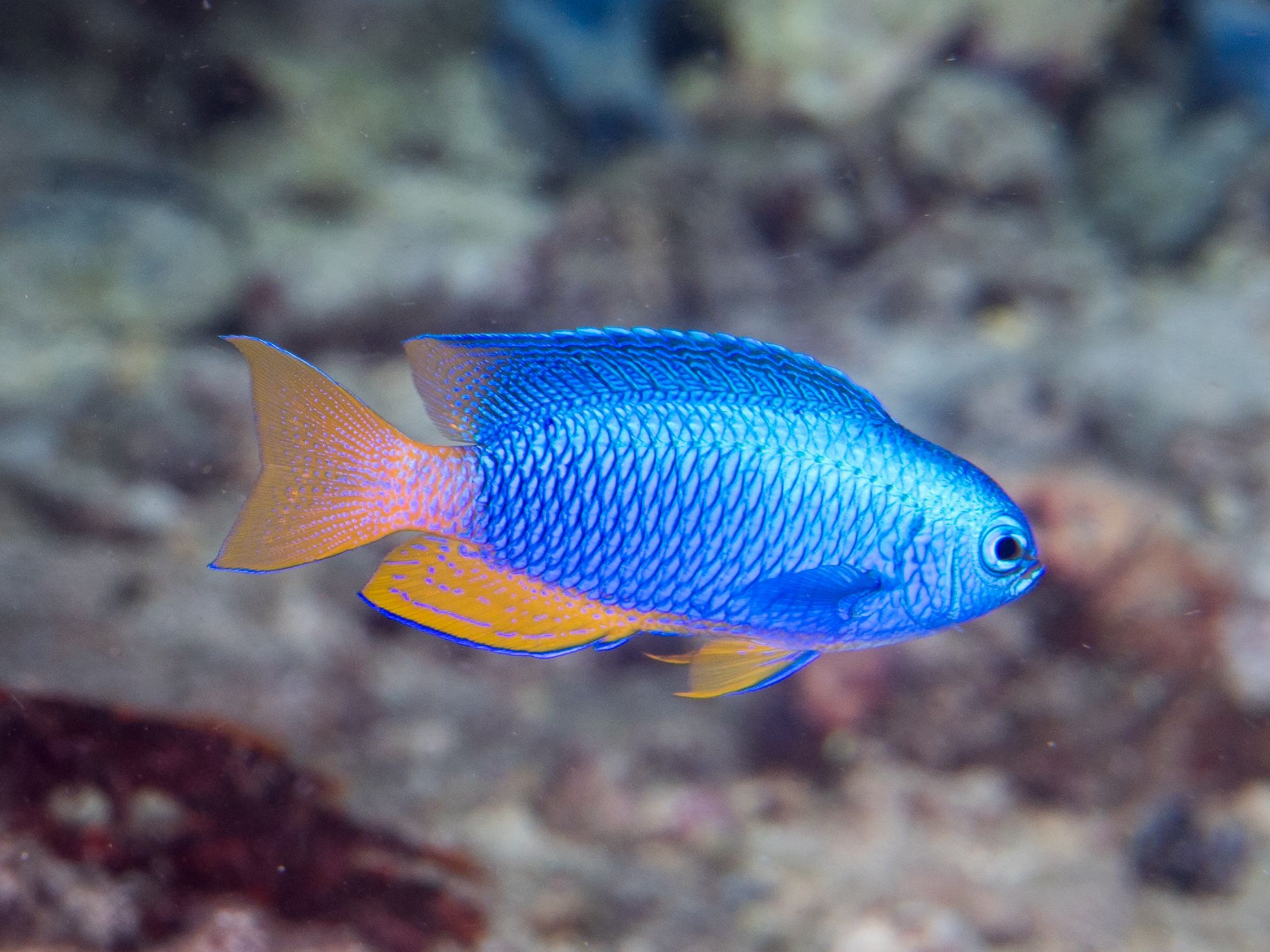
Allen’s Damselfish, which also somehow secured the name Neon Damselfish (they all seem a bit Neon to me), has brilliant blue coloration on the majority of its body, with gold highlights on the ventral, anal and caudal finds, interspersed with blue flecks. They are quite attractive, and also semi-aggressive, just like the rest of the fish on this list.
| Scientific name | Pomacentrus alleni |
| Minimum tank size | 20-gallons (75.7 L) |
| Adult fish size | 2.5 in. (6.4 cm) |
| Aggressiveness | Semi-aggressive |
| Reef safe | Yes |
| Care level | Easy |
10. Lemon Damselfish

If you are interested in having a small, but mighty burst of yellow in your tank, the somewhat overlooked Lemon Damselfish is an attractive damselfish type.
| Scientific name | Pomacentrus moluccensis |
| Minimum tank size | 20-gallons (75.7 L) |
| Adult fish size | 2.75 in. (7 cm) |
| Aggressiveness | Semi-aggressive |
| Reef safe | Yes |
| Care level | Easy |
11. Ambon Damselfish

| Scientific name | Pomacentrus amboinensis |
| Minimum tank size | 20-gallons (75.7 L) |
| Adult fish size | 3.5 in. (8.9 cm) |
| Aggressiveness | Semi-aggressive |
| Reef safe | Yes |
| Care level | Easy |
12. Pink Smith Damselfish
Having a little fun with the image above, but the Pink Smith Damselfish (also popularly called Demoiselle) is a relatively subtly colored beauty.
| Scientific name | Pomacentrus smithi |
| Minimum tank size | 20-gallons (75.7 L) |
| Adult fish size | 2.75 in. (7 cm) |
| Aggressiveness | Semi-aggressive |
| Reef safe | Yes |
| Care level | Easy |
13. Regal Damselfish
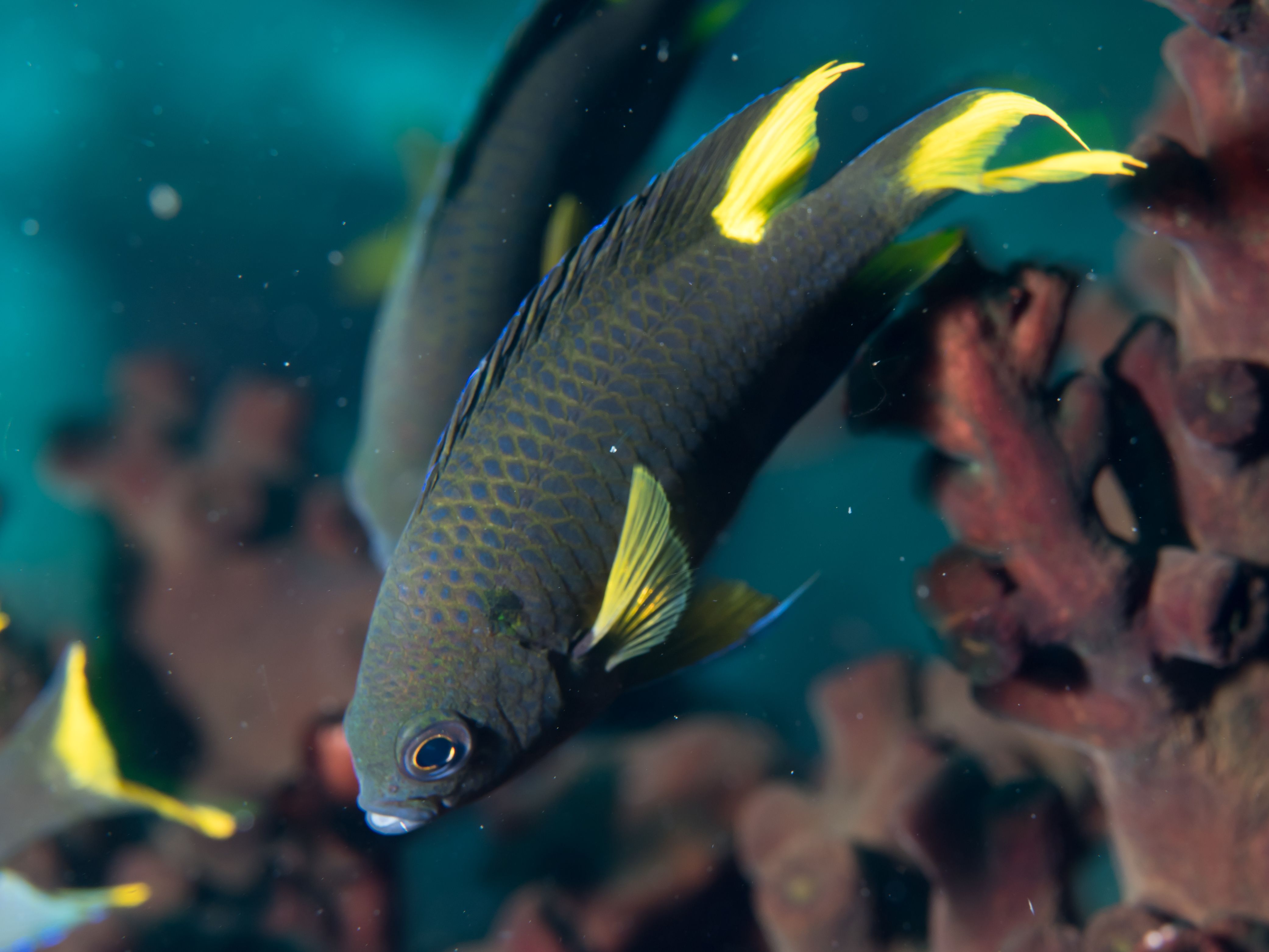
| Scientific name | Neopomacentrus cyanomos |
| Minimum tank size | 20-gallons (75.7 L) |
| Adult fish size | 3 in. (7.6 cm) |
| Aggressiveness | Semi-aggressive |
| Reef safe | Yes |
| Care level | Moderate |
14. Three stripe Damselfish (Humbug)

The Three Stripe Damselfish has one of the BEST alternate common names–Humbug! They look very similar to the Four Stripe Damselfish, except with no stripe on the tail.
These beautiful fish are often sold as tiny juvenile fish that are commissioned to be the first fish in a new saltwater tank. This causes problems later on, due to their aggressive dispositions.
| Scientific name | Dascyllus aruanus |
| Minimum tank size | 20-gallons (75.7 L) |
| Adult fish size | 3.75 in. (9.5 cm) |
| Aggressiveness | Semi-aggressive |
| Reef safe | Yes |
| Care level | Easy |
15. Four stripe Damselfish

The Four stripe Damselfish is so named because of the three bold stripes on the body of the fish, as well as the fourth stripe of black that covers the tail-end of the caudal fin. Hah! Tail end!. Go ahead, scroll back up, you’ll see. They look almost identical to the Three stripe except for the black tail.
This is a popular and common damselfish type, but they are not always a great choice for the peaceful community tank due to their aggression.
| Scientific name | Dascyllus melanurus |
| Minimum tank size | 20-gallons (75.7 L) |
| Adult fish size | 3.25 in. (8.3 cm) |
| Aggressiveness | Semi-aggressive |
| Reef safe | Yes |
| Care level | Easy |
16. Two Stripe Damselfish
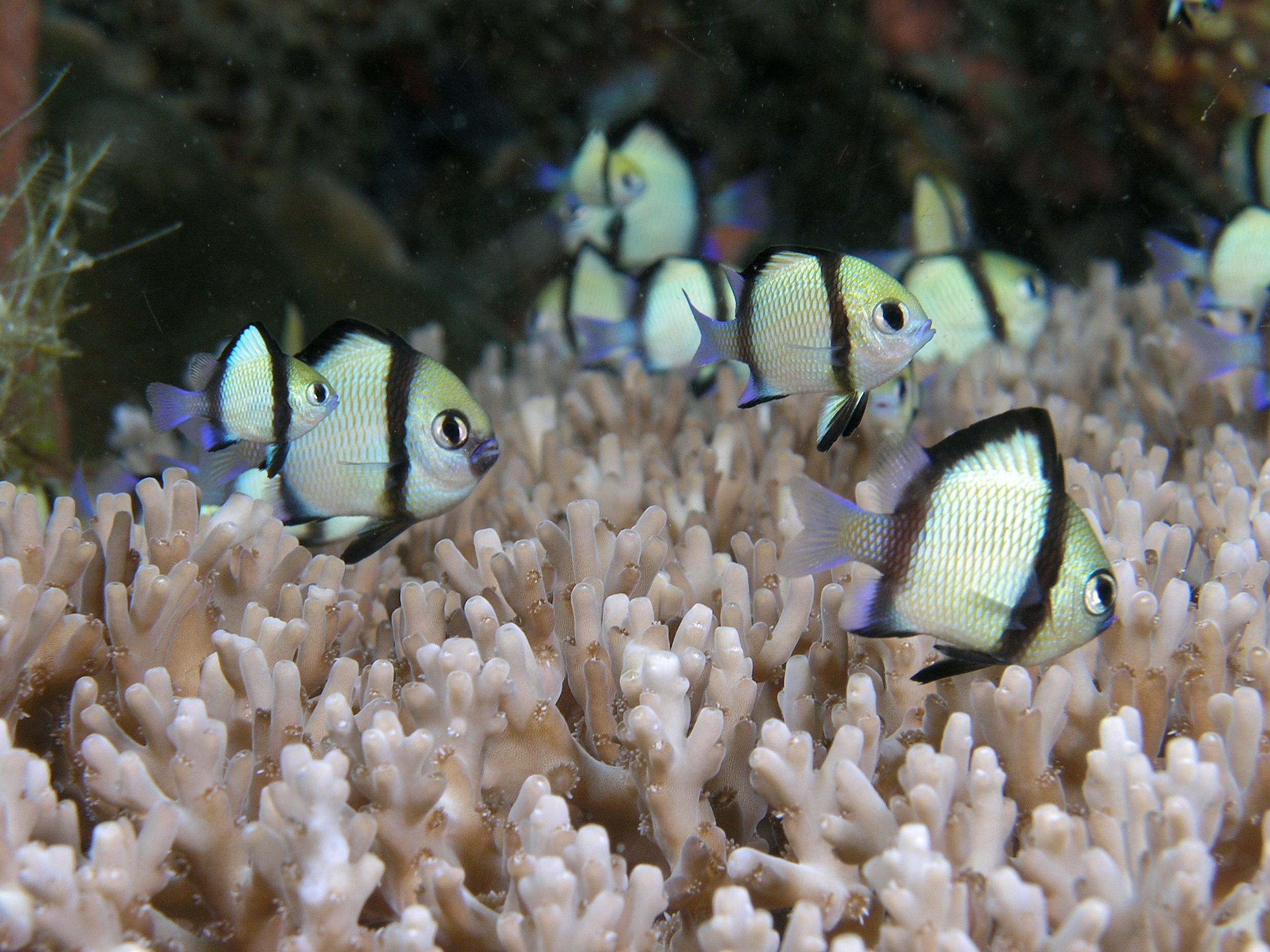
| Scientific name | Dascyllus reticulatus |
| Minimum tank size | 55-gallons (208.2 L) |
| Adult fish size | 3.5 in. (8.9 cm) |
| Aggressiveness | Aggressive |
| Reef safe | Yes |
| Care level | Easy |
17. Three Spot Domino Damselfish

The Three Spot Domino Damselfish is one of the larger damsels on this list. They should be kept in a tank that is 55-gallons or larger, because they will reach ~5.5 inches as adults. As you can see in the image, they do like to live amongst the tentacles of anemones, just like clownfish.
There is some risk that any/all damselfish will eat invertebrates small enough to swallow. That risk increases with larger species, like the Domino.
| Scientific name | Dascyllus trimaculatus |
| Minimum tank size | 55-gallons (208.2 L) |
| Adult fish size | 5.5 in. (14 cm) |
| Aggressiveness | Semi-aggressive |
| Reef safe | Yes |
| Care level | Easy |
18. Bluefin Damselfish

Topping the charts at a full 7-inch adult length, the substantial Bluefin Damselfish is one of the largest and most aggressive type of damselfish you will encounter at your local fish store. You likely won’t see a full-sized adult, but rather the tiny, cute, seemingly harmless 1.5-2 inch juvenile. But these fish grow up to be quite large in size and are not afraid to throw around their weight.
With that said, they are hardy, reef safe, and easy to care for.
Unnecessary commentary from the author (me): I find it interesting that the common name for Neoglyphidodon melas is the Bluefin Damselfish. They clearly do have blue highlights to their ventral fins, which is a distinguishing feature, but I’m not sure it captures the essence of the fish.
| Scientific name | Neoglyphidodon melas |
| Minimum tank size | 55-gallons (208.2 L) |
| Adult fish size | 7 in. (17.8 cm) |
| Aggressiveness | Semi-aggressive |
| Reef safe | Yes |
| Care level | Easy |
19. Ternate Damselfish

| Scientific name | Amblyglyphidodon ternatensis |
| Minimum tank size | 20-gallons (75.7 L) |
| Adult fish size | 3 in. (7.6 cm) |
| Aggressiveness | Semi-aggressive |
| Reef safe | Yes |
| Care level | Easy |
20. Blue Velvet Damselfish
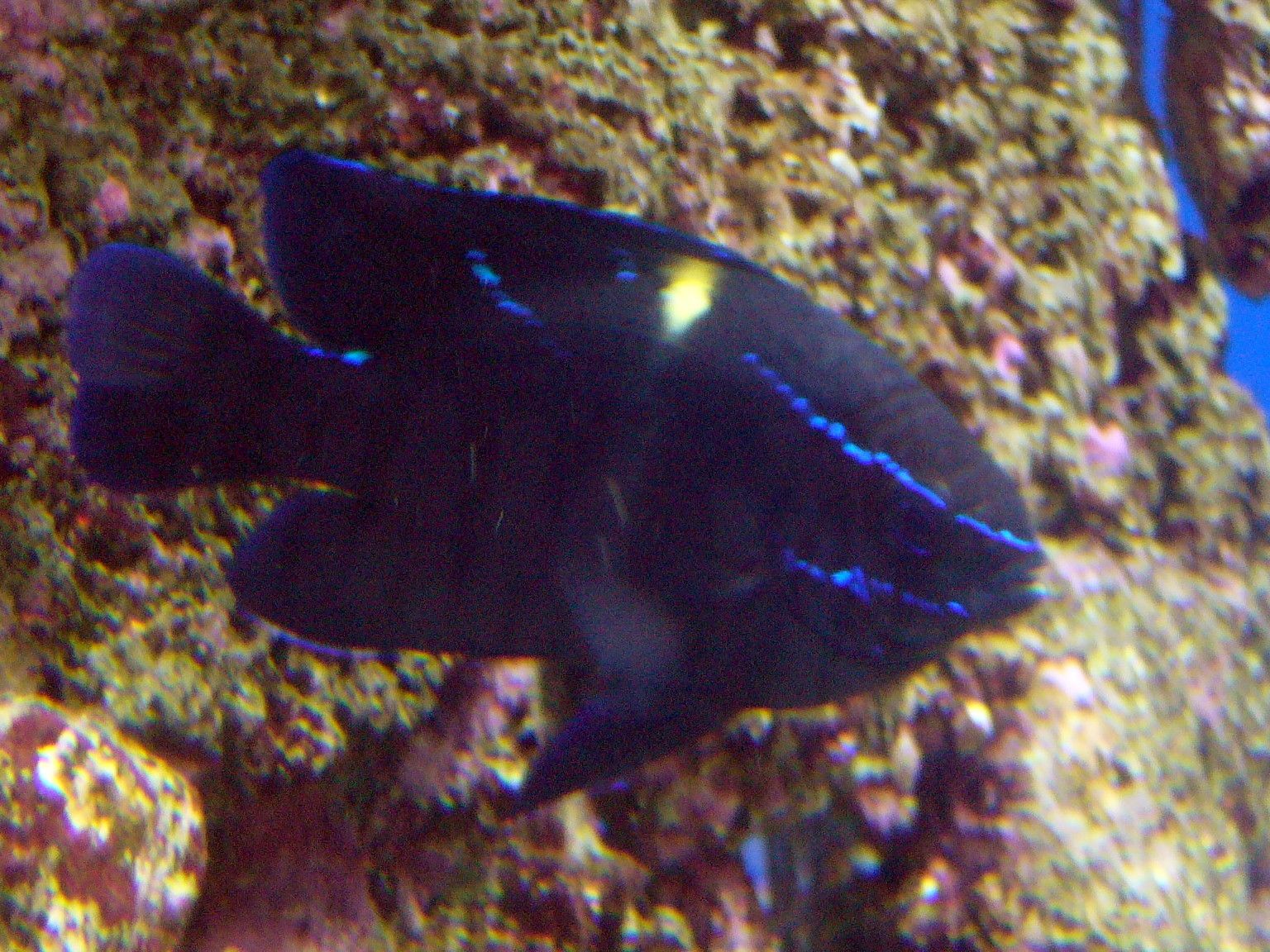
The Blue Velvet Damselfish is a commonly stocked and attractive fish as a juvenile that grows to be very large (6 inches/15 cm) as an adult. They are also one of the less fortunate fish, that like me, becomes less attractive as an adult than as a juvenile :).
The blue neon/velvet stripes fade to become a predominantly drab/dark colored and aggressively dispositioned large fish.
Buyer beware.
| Scientific name | Paraglyphidodon oxyodon |
| Minimum tank size | 20-gallons (75.7 L) |
| Adult fish size | 6 in. (15.2 cm) |
| Aggressiveness | Semi-aggressive |
| Reef safe | Yes |
| Care level | Easy |
21. Jewel Damselfish

Hard to believe we can come to the bottom of the list of popular damselfish types and just be getting to the Jewel Damselfish, but that is a testament to how diverse and attractive these beauties are. The Jewel is another one of the larger fish on this list, growing to about 6 inches/15 cm in total length as adults.
They are reef safe towards corals, but may be a problem if you stock small invertebrates, as they are opportunistic hunters.
| Scientific name | Microspathodon chrysurus |
| Minimum tank size | 55-gallons (208.2 L) |
| Adult fish size | 6 in. (15.2 cm) |
| Aggressiveness | Semi-aggressive |
| Reef safe | Yes |
| Care level | Easy |
Which is the most peaceful damselfish type?
Based on reputation and personal experience, the most peaceful damselfish types are likely Springer’s, Yellowtail, and the Azure damselfish, which also makes them the least aggressive. However, there is no definitive or authoritative way to rank the aggressiveness of different fish species.
You may notice that these are all members of the Chrysiptera genus, a group of relatively smaller and directionally more peaceful type of damselfish.
There is an ancient Saltwater Aquarium Blog proverb passed down from my elders that states:
“The most peaceful damselfish is the one that is not in your tank.”
Ancient Saltwater Aquarium Blog Proverb etched into a stone tablet found in my deep sand bed
What are the most aggressive damselfish types?
The most aggressive damselfish types are the Blue Devil, Two stripe, Three stripe, Three spot, Four stripe, Bluefin, Velvet, and Jewel Damselfish.

If you’re thinking…that’s a lot of species…you are right. Damselfish can be quite aggressive.
Interestingly enough, Saltwater Aquarium Blog elders also passed down a proverb about this:
“The most aggressive damselfish is the one that is in your tank.”
Ancient Saltwater Aquarium Blog Proverb etched into a stone tablet found in my deep sand bed

Can you mix different damselfish?
Most damselfish are aggressive or semi-aggressive saltwater fish. Mixing different damselfish, or even two or more of the same type of damselfish can be tricky, but it is possible. To do so, here are 5 tips to help:
- Add them to the quarantine tank and display tank at the same time
- Combine similarly-sized individuals (both current size and anticipated adult size)
- Choose similarly aggressive species
- Add 3 or more from each species
- Add cleaner fish and shrimp to the tank
1. Add damselfish to the tank at the same time to disperse aggression
Damselfish aggression is generally thought to be in response to a natural tendency to protect and defend their territory from interlopers. If you add the damsels at different times, the incumbent fish will have already established a territory and will therefore be more aggressive in protecting it.
When the fish are all introduced at the same time, they establish a hierarchy and divide up the available space. Assuming there is enough room for everyone, the end result should be a more balanced distribution of territory.

2. Choose similarly sized fish to avoid bullying
The smallest Damselfish species grow only to about 2 inches (5 cm) in le.ngth as fully grown adults, while others grow to 6 or 7 inches (15.2 or 17.8 cm)!
Damselfish can sometimes be tank bullies. Just like all bullies, their first option is to pick on someone they perceive as weaker than themselves. One of the quickest ways to create that imbalance is to mix damselfish species that are different sizes today.
You will also want to be careful not to mix damselfish species that will be dramatically different sizes in a few months. Even though they may all be cute ~1.5 inch juveniles in the tank at your local fish store, mixing a 7-inch Bluefin Damselfish with a ~2-3 inch Azure Damselfish will result in a David vs. Goliath situation before long.
3. Choose similarly aggressive species to strive for balanced aggression
Attempting to manage aggression in an aquarium is a bit like fighting fire with fire. Your goal is to achieve balance. So if you want to mix damselfish species, you will likely have the greatest success if you try to mix damsels with similar aggressive dispositions. Don’t mix semi-aggressive varieties with semi-peaceful.

4. Choose larger, odd numbers of fish to strive for dispersion of aggression
One interesting aspect of aggression exerted by aggressive fish species is that it tends to be relatively constant. As long as the aggressor has energy, feels safe, and can see the threat, they will likely attack and defend.
So one of the strategies to help manage aggression in fish is to have many, similarly aggressive fish all together. When that occurs, there is less ‘picking’ on a weaker individual, and instead, the aggression is spread out on several other targets. Since we also carefully selected those “targets” to also be similarly aggressive, they, too, have their own targets, and so on.
In that way, you create a web of dispersed aggression, which helps prevent any one or two fish from becoming targeted so much that they become sick, injured, or worse.
5. Add cleaner fish and shrimp to the tank
There was a scientific study many years ago demonstrating that cleaner fish reduce aggression in a saltwater aquarium. Essentially, the more the fish in the study got cleaned by the cleaner wrasse, the less aggression they displayed–not just because of the ‘time outs’ but it somehow soothed the savage underwater beasts.

I can’t say for sure whether or not that specific insight could be successfully applied to this situation, but cleaner fish and shrimp are awesome…so why not give it a try?
Do damsels get ich?
Ich, “ick” or “white spot disease,” is caused by a parasite that attacks the gills and skin of saltwater aquarium fish, including damsels and damselfish.
Why is my damsel turning white?
If you see your damsel turning white at night, looking more pale than during the day, this is a normal, routine event, as part of preparation for rest. If your damsel is turning white during the day, it could be a symptom of stress, illness, or malnourishment.

If your damsel is turning white, you should try to remove the cause of the stress and see if you can improve the nutritional quality of the food.
Can damselfish live with clownfish?
Damselfish and clownfish are likely to be aggressive towards each other and should not live together in the same saltwater tank, unless you have a very large aquarium.
Are damselfish hardy?
Damselfish are some of the most hardy saltwater fish available for a marine aquarium. They are tolerant of less-than-perfect water parameters, eager to eat the majority of available foods and most live a long time. Damselfish are often one of the first fish added to a new saltwater tank because they are so hardy.
Caution is advised though, because most damselfish species can be moderately aggressive, which can cause problems when you try to add your second, third and subsequent fish. So although their constitution is hardy, making them an ideal starter fish, their aggressive behavior is not.
Can damselfish change color?
Damselfish can change color and will change color to a lighter/paler shade at night and to a darker shade when stressed or scared. Springer’s damselfish will turn from blue to almost black when stressed and trying to avoid a predator.
Are damselfish jumpers?
All saltwater fish are somewhat susceptible to jumping out of an aquarium with no lid if they feel sufficiently startled but damselfish a moderate risk of being a “jumper,” similar to that of a clownfish. Dartfish, wrasses, and jawfish are notorious jumpers.
References
Michael, Scott W. Marine Fishes: 500+ Essential-to-Know Aquarium Species. TFH Publications, Inc. Neptune City, NJ 2001
Live Aquaria
[ad_2]
Source link
